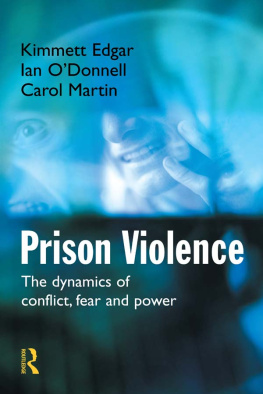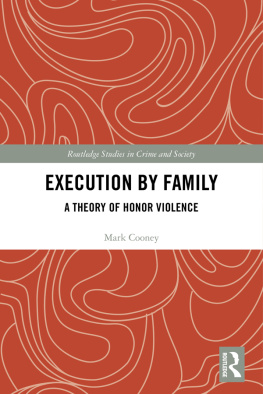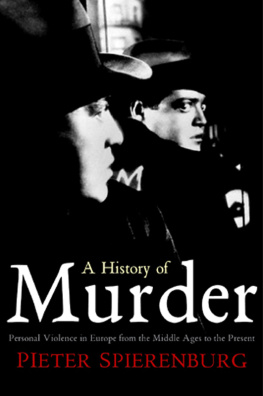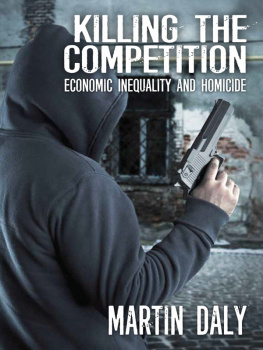Warriors and Peacemakers
Warriors and Peacemakers
How Third Parties Shape Violence
Mark Cooney

Thank you for buying this ebook, published by NYU Press.
Sign up for our e-newsletters to receive information about forthcoming books, special discounts, and more!
Sign Up!
About NYU Press
A publisher of original scholarship since its founding in 1916, New York University Press Produces more than 100 new books each year, with a backlist of 3,000 titles in print. Working across the humanities and social sciences, NYU Press has award-winning lists in sociology, law, cultural and American studies, religion, American history, anthropology, politics, criminology, media and communication, literary studies, and psychology.
NEW YORK UNIVERSITY PRESS
New York and London
Copyright 1998 by New York University
All rights reserved
Grateful acknowledgment is given to Richard B. Lee and Cambridge
University Press for permission to quote from The !Kung San: Men,
Women, and Work in a Foraging Society, 1979.
Library of Congress Cataloging-in-Publication Data
Cooney, Mark, 1955
Warriors and peacemakers : how third parties shape violence /
Mark Cooney
p. cm.
Includes bibliographical references and index.
ISBN 0-8147-1514-1 (clothbound : acid-free paper).
ISBN 0-8147-1567-2 (paperback : acid-free paper)
1. Violence. 2. Interpersonal conflict. 3. Homicide. 4. Third
parties (Law) I. Title.
HM291.W315 1998
303.6dc21 97-45350
CIP
New York University Press books are printed on acid-free paper,
and their binding materials are chosen for strength and durability.
Manufactured in the United States of America
10 9 8 7 6 5 4 3 2 1
To my mother and father
Preface
The social study of violence made enormous progress in the latter half of the twentieth century. We know vastly more about virtually all facets of violence than our predecessors did in, say, 1950. An impressive body of reliable information now exists on who kills whom, when and where killings take place, the nature of gang and tribal feuding, the interactional dynamics of violence, and the macrostructural predictors of rates of violence, as well as many other topics.
Even so, we know far less than we could, for there remain several underdeveloped lines of inquiry. One, perhaps surprisingly, is the role played by people other than the principal parties who have or are likely to have information about the conflictthird parties, such as relatives, friends, neighbors, workmates, strangers, or legal officials. A moments reflection reveals that third parties must often exert a powerful influence on the course disputes take. They may be a force for violence or for peace, acting as warriors, peacemakers, or something in between.
The central intellectual issue is when third parties will wage war and when they will make peace. I argue in this book that the explanation is to be found in the social status and ties of third parties. Of critical importance is whether third parties are close to or distant from the principals, and whether they are above, below, or of the same status. Some combinations of third-party ties and status promote and intensify the violent handling of conflicts, transforming apparently minor grievances into long-standing and bitter feuds; others attract efforts to find a peaceful resolution of the disagreement, whether in the form of authoritative legal pronouncements by a judge or the amicable exhortations of a person caught between two friends quarreling.
These ideas draw heavily on the pioneering work of Donald Black. Black has formulated a body of extremely wide ranging theory that predicts and explains how people handle conflictwhether they will execute, boycott, or imprison; banish, negotiate, or sue; seek therapy, threaten, or demand paymentin every society, at all times. My own work, though considerably more narrowly focused, similarly incorporates data from anthropology, criminology, sociology, history, and other disciplines, as well as from two studies I conducted myself.
Although primarily designed to order some of the known facts of violence, the theoretical propositions I present in this book have practical applications, suggesting a strategy for reducing violence centered around two corps of third parties. In addition, I hope the propositions will encourage students of violence to explore third-party effects in greater detail. Indeed, should they do that, I will judge my efforts successful, even if the ideas prove to be misstated or, in the worst case, false.
For all the help, intellectual and otherwise, he has given me over the years, including comments on a draft of this book, I would like to thank Donald Black. Other colleagues and friends who have been especially supportive in a variety of ways during the gestation period of this book are M. P. Baumgartner, James Dowd, John Herrmann, Alan Horwitz, Calvin Morrill, Jeff Mullis, Barry Schwartz, Roberta Senechal de la Roche, and James Tucker. I have presented portions of this work at several conferences and received valuable feedback from many people, including Kit Carson, Russell Dobash, Richard Felson, Peter Grabosky, Richard Leo, Peter Manning, and Joachim Savelsberg. Leonora and Carl OSullivan read and responded to an early draft. Connie Kennedy helped with editing. Scott Phillips and Kerri Smith provided comments on the manuscript and help in preparing the references and tables. None of these individuals will agree with everything this book contains, but each has my gratitude for contributing to its evolution.
I wish to express my appreciation of the Department of Sociology at the University of Georgia for providing me with a hospitable environment in which to write this book. Earlier, I received support from the University of Virginia and the Center for Criminal Justice at Harvard Law School. To both institutions, I am grateful.
At a personal level, my greatest debt is to my friend, lover, and spouse, Mary Kelly. She and our two children, Nicolas Tendai and Zara, have provided me with more happiness and support than anybody deserves. Finally, in acknowledgment of all that they have done, and continue to do, for me and my circle of intimates, I dedicate this book to my parents.
1
Introduction
It was a Saturday in September. They were having a function in a local park. Me and another guy, George, went along on bicycles. It didnt make sense to try and drivethere were too many cars. The bike George was on was stolen. As we were riding through the park, a guy came up to George and said that he was on his bike which had been stolen. George said it might look like his bike but it wasnt. The guy left.
We were in the park about an hour. When we were leaving, the guy who had come up to George before came up to him again. This time he had about five or six other guys with him. We didnt know them. The guy said that the bike was his. George said it wasnt. He said it was again and he then grabbed the bike by the handlebars. George told him to take his hands away. He said I aint taking my hands away, Im taking the bike away. We started to argue.
The guy then told one of his friends to get a wrench out of the trunk of the car they was in. George asked him what that was for and then punched him in the face. A fight broke out. There were too many of them. One of them took the bike and put it in the trunk. The rest of them jumped in the car and left.
We went back to where we lived and suited up. We took a couple of sawed-off shotguns and some nine millimeter pistols. Then we went looking for them.
Next page






